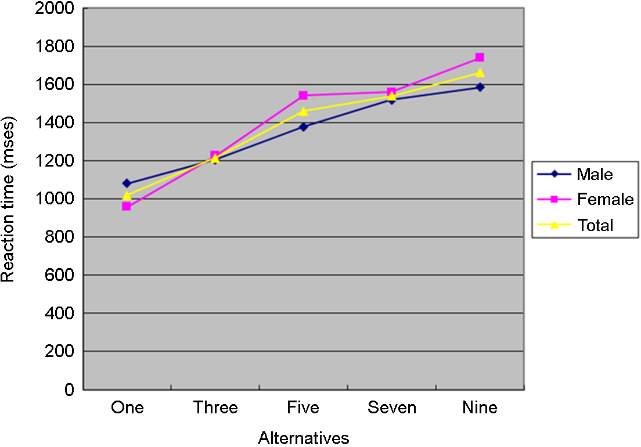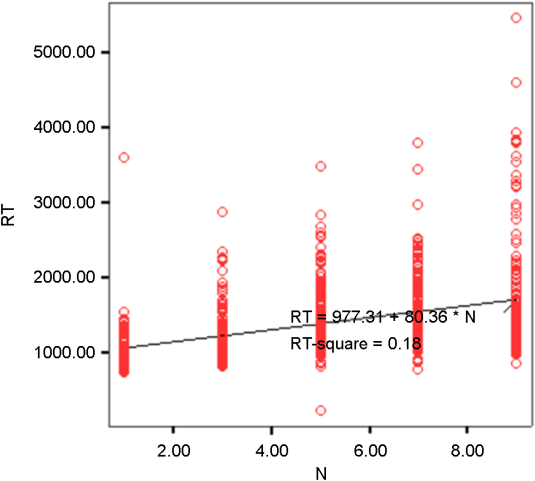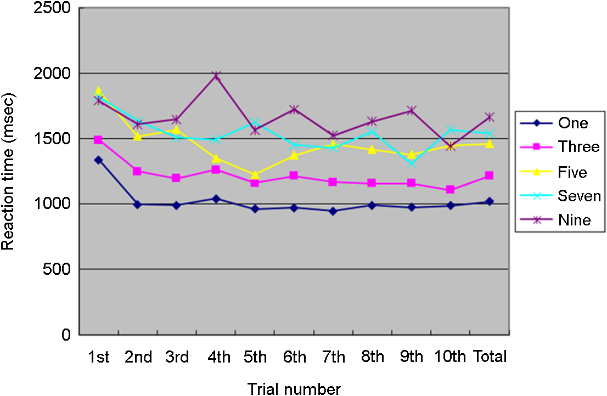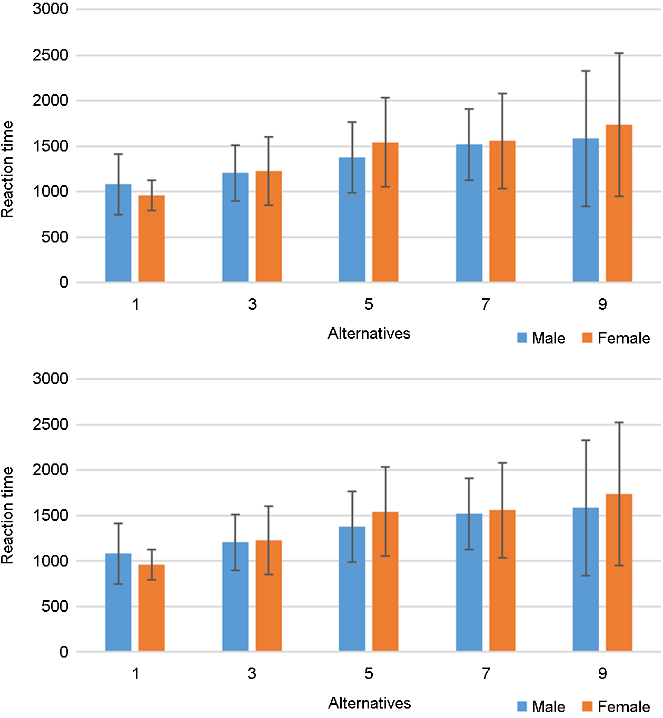eISSN: 2093-8462 http://jesk.or.kr
Open Access, Peer-reviewed

eISSN: 2093-8462 http://jesk.or.kr
Open Access, Peer-reviewed
Pier Paolo Capestrani
, Yejin Lee
, Kwang Tae Jung
10.5143/JESK.2023.42.4.315 Epub 2023 August 30
Abstract
Objective: The objective of this study is to identify the characteristics of the elderly's choice response for elderly-centered universal design.
Background: The importance of universal design is increasing due to the growing number of elderly people. To develop a universal design centered on the elderly, research identifying the elderly's characteristics from various perspectives is necessary.
Method: An experiment was conducted on a computer to measure the choice reaction time of the elderly. The independent variable was the number of stimulus alternatives, and the dependent variable was the reaction time in each experimental condition. Ten replications were performed for each experimental condition.
Results: As the number of alternatives increased, the choice reaction time of the elderly increased for both men and women, and was appropriately expressed by the formula to which Hick's law was applied. In the case of a simple reaction, the reaction time of men was longer than that of women. However, when the number of choice options was three or more, the reaction time of women was longer. This indicates that as the number of alternatives increases, the decision-making time of elderly women also increases.
Conclusion: The experimental results show that the number of choice alternatives significantly effects the elderly's choice reaction time.
Application: The results of this study can be used as basic data for the universal design of products or facility user interfaces.
Keywords
Universal design Choice reaction time Hick's law User interface
The number of elderly people aged 65 or older in Korea exceeded 9 million for the first time in 2022, accounting for 17.5% of the total population. By 2025, the proportion of the elderly population is expected to reach 20.6%, transforming Korea into a super-aged society (Statistics Korea, 2022). It is estimated that Korea will transition from an aged society, with more than 14% of the population being elderly, to a super-aged society, with over 20% of the population being elderly, in just 7 years. This is much shorter than 10 years in Japan, 15 years in the US, 50 years in the UK, etc. As the aging population rapidly increases, issues of welfare for the elderly, such as service, environment, and product development for the elderly, are emerging as serious social problems, and ergonomic design concepts in services, environments, and products are becoming more important (Arthur, 1999).
Compared to young adults, the elderly have significantly reduced abilities in physical, sensory, and cognitive functions (Wendy, 1997). Therefore, products or facilities designed for young adults often present difficulties in use for the elderly, and in some cases, may cause serious accidents. Unfortunately, however, most of the products and facilities encountered in daily life are designed for young and able-bodied individuals. Therefore, to ensure the accessibility, usability, and safety for the elderly, it is necessary to consider their characteristics when designing products, facilities, services, and environments. To this end, it is necessary to study the characteristics of the elderly regarding the use of products, facilities, services, and environments to identify those characteristics.
Universal design is the concept that even disadvantaged individuals, such as the elderly or the handicapped, should be able to use a product or system easily without the need of a separate device or specific design alterations (Ronald, 1999; Jung, 2004). As an important factor determining the quality of life, the provision of an environment where people can live independently without inconvenience led to the need for universal design, which eventually spread as an effort to approach an expanded concept of usability.
For universal design, it is necessary to first understand the characteristics of various users. In particular, it is necessary to study various characteristics related to system use because the elderly or the disabled are likely to be users belonging to the extremes in using the system.
Due to the recent spread of digital devices and services, the cognitive burden of users is increasing. Users must perform appropriate actions in reaction to various stimulus information provided by the system. In this regard, the characteristics of choice reactions can be important considerations in designing a digital system. In particular, in terms of universal design, it is important to investigate the choice reaction characteristics of the elderly. Therefore, in this study, an experimental study was conducted to identify the characteristics of the elderly's choice reaction.
Universal design is distinct from accessible design, which is typically applied only for a specific group. Accessible design is a design that caters to a specific user (especially the disabled) distinguishing them from the general users. Accessible design involves designing a product or a building so that it can be used by a specific user, such as those with disabilities. On the other hand, universal design aims to be inclusive so that everyone can use it together. For example, if a ramp is installed along with stairs at the entrance of a building, it constitutes accessible design. However, if it provides only a ramp that everyone can use, it is a universal design. In this respect, universal design first emerged in the design of buildings and environments used by unspecified individuals. Later, many design colleges expanded this approach to various product and service fields. In that context, the seven principles of universal design, which were researched and announced at the Universal Design Center of the North Carolina State University, are applied in many fields as basic principles for universal design (The Center for Universal Design, 2000; Jung, 2007).
For universal design, studying the characteristics various users is a necessary first step. In particular, in the case of Korea, which has entered the aging society, it is necessary to study various characteristics of elderly users and reflect them in design.
According to such necessity, there are various cases of studying the characteristics of the elderly for universal design. Jung et al. (2004) conducted a comparative study on the depth perception of the young and elderly for universal design. In this study, the depth perception characteristics of 22 college students and 23 elderly people were measured by varying the viewing distance, and based on this, it was confirmed through experiments that college students showed much more accurate depth perception than the elderly. In addition, it was found that both the elderly and young adults had lower depth perception in males than in females. These results can be effectively used in the design of products requiring depth perception.
Song et al. (2000) conducted a study on the universal design of microwave ovens considering elderly users. In this study, the characteristics of the elderly for the universal design of microwave ovens were identified through a survey and usability evaluation targeting elderly users. Reflecting these results, the user interface of the microwave oven was redesigned to facilitate easy use by the elderly.
Jung and Song (2003) conducted a study on usability evaluation by the elderly and the design improvement of the washing machine's user interface. In addition, physiological signals while using the handle of the washing machine were measured and analyzed. Finally, considering the characteristics of the elderly, a universal design model was developed for the user interface of the washing machine.
Hong (2007) extracted design factors related to the universal design of mobile phone keypads through a study on the universal design of the mobile phone Hangul input method. He measured satisfaction with cell phone text speed, text input speed and error rate for young and elderly people. Since both the young and elderly were satisfied with the text speed of their mobile phones, it was argued that improving the text input speed is not a crucial design factor in terms of universal design. In addition, preference for consonant placement did not show any difference according to age, and both young and old preferred to place vowels on the top or right. The elderly showed low character input speed and error rate on keyboards that were easy to remember the position of vowels, and both young and old showed efficient character input speed and error rate on design keyboards with excellent memory.
Noh and Park (2008) identified user characteristics through a user interface study of a touchscreen mobile phone with universal design considerations, and proposed a user interface prototype of a touchscreen mobile phone based on these results. Jung (2009) presented an age-friendly product design, considering universal design principles, characteristics of the elderly, and ergonomic principles in the study of product design for the elderly. Jun (2015) conducted a study on the establishment of color guidelines for universal design in consideration of the elderly. She compared and analyzed the visual characteristics of the general persons and the elderly to improve the color guidelines of public facilities. From the perspective of the elderly, it is important to clearly distinguish differences in brightness of colors, with changes in color perception depending on the alteration or location of colors being evident. And, it was said that various design elements other than color are needed when the amount of visual information increases or when color perception is difficult. You (2020) conducted basic research on the characteristics of the elderly and children with regards to universal design, and suggested a direction of universal design based on these findings.
Looking at the studies above, various studies have been conducted on the characteristics of the elderly for universal design. However, no study has been identified that focuses on the elderly's choice reaction to stimuli. Since the choice reaction of the elderly are characteristics that should be considered important in user interface design, it is important to conduct research on them.
In this study, an experiment was conducted in which participants pressed the button corresponding to the presented stimulus to examine the characteristics of the elderly's choice reaction. The independent variable of the experiment was the number of stimulus alternatives presented, and the measured variable was the reaction time in each experimental condition. As for the number of alternatives, 1, 3, 5, 7, and 9 stimuli were targeted, with natural numbers from 1 to 9 serving as for stimuli. Experiments were performed on a computer.
Participants viewed a number presented on the computer screen and engaged in an experiment where they pressed the corresponding number button. Numeric buttons used the numeric keypad of the keyboard. The experiment was conducted with keys other than the number keys covered.
Participants became familiar with the experimental method through a preliminary experiment before the start of the main experiment. Before the start of the experiment, the subjects waited with their hands in the designated position.
For efficient progression of the experiment, a program was developed for the presentation of stimuli and the measurement of the time elapsed from the presentation of the stimuli to the pressing of the corresponding number key. The experiment was repeated 10 times for each experimental condition. The number of participants in the experiment was 16, consisting of 8 males and 8 females, with an average age of 72.6 for males and 71.3 for females. Participants selected for the experiment were elderly individuals who had no issues seeing and understanding the numbers presented on the monitor. The specific experimental procedure is as follows.
① The experimenter inputs the number of alternatives and repetitions in the experiment program.
② The experimenter presents the stimulus on the monitor by pressing the space bar on the keyboard.
③ The subject presses the button corresponding to the number presented on the monitor.
④ Repeat steps 2 and 3 as many times as the number of repetitions
⑤ When the experiment for one condition is completed, the experimenter records the experiment result.
⑥ Repeat steps 2 to 5 for all experimental conditions.
⑦ Repeat steps 1 to 6 for all subjects.
4.1 Reaction time according to the number of alternatives
Figure 1 is a graph depicting the average reaction time in relation to the number of alternative options. Examining at the graph, it can be observed that the reaction time increases as the number of alternative options increases, with the difference being statistically significant at the 0.05 of significance level (F=45.625, p=0.000). In addition, the results were the same for both males and females.

Figure 2 displays the scatter plot and regression equation relating the number of alternatives and the reaction time. It can be seen that the reaction time tends to increase as the number of alternatives increases. This finding aligns with Hick's Law, which states that reaction time increases as the number of alternatives increases (Proctor and Schneider, 2018). Therefore, according to Hick's law, the reaction time of the elderly is estimated as follows. Here, N represents the number of possible alternatives.

4.2 Reaction time according to repetition
Examining Figure 3, which depicts the average reaction time based on the repetitions of the experiment, the average reaction time in the first trial was the greatest, and as the experiment was repeated, the average reaction time showed a decreasing trend.

Furthermore, the difference proved statistically significant at the significance level of 0.05 (F=3.275, p=0.001). However, examining the results of the post-hoc test (Duncan test) displayed in Table 1, the average reaction time for the 2nd to 9th repetitions was analyzed within the same group. This trend can be corroborated by Figure 2, and independent of the number of alternatives, it can be observed that the fluctuation in average reaction time is minimal from the second trial. In essence, in the choice reaction experiment targeting the elderly, it can be seen that the learning effect based on the number of trials appears negligible, independent of the number of alternatives in the average reaction time. These findings were confirmed through the results of significance analysis concerning the interaction effect between the number of alternatives and repetition. In other words, the interaction effect between the number of alternatives and repetition was not statistically significant at the significance level of 0.05 (F=0.638, p=0.952).
Replication | N | Group | |
1 | 2 | ||
7 | 80 | 1304.29 |
|
9 | 80 | 1305.63 |
|
5 | 80 | 1307.22 |
|
10 | 80 | 1310.16 |
|
6 | 80 | 1346.31 |
|
8 | 80 | 1350.08 |
|
3 | 80 | 1381.19 |
|
2 | 80 | 1400.99 |
|
4 | 80 | 1424.49 |
|
1 | 80 |
| 1660.51 |
Sig. |
| .195 | 1.000 |
4.3 Reaction time according to gender
Inspecting Figure 4, which illustrates the average reaction time by gender, the reaction time for elderly male was significantly higher for a simple reaction (when the number of alternatives was 1). However, when the number of alternatives was three or greater, the average reaction time for elderly females was marginally longer than that of the elderly males, and the deviation in reaction time was also more pronounced in the elderly females. However, the difference was not statistically significant at the significance level of 0.05 (F=2.175, p=0.141).

Given the swift advancement of population aging and the growing economic independence of the elderly, the number of elderly users of products, facilities, and services is rapidly increasing. This amplifies the importance of incorporating considerations for the elderly in universal design of user interface design of products and facilities. To this end, various characteristics of the elderly that can be utilized in the universal design process considering the elderly should be studied.
In response with this need, this study was conducted to uncover the characteristics of the elderly's choice reaction for elderly-centered universal design. As the number of available alternatives for choice increased, the elderly's choice reaction time increased, a trait found to be consistent across genders. The relationship between the number of choice alternatives and the choice reaction time was appropriately expressed by the formula applying Hick's law.
The analysis of the effect of repetition on the choice reaction demonstrated that choice reaction time tended to decrease as the experiment was repeated, yet this decrease was insignificant even if the number of repetitions rose to two or more. Nevertheless, the reduction in reaction time was notable for both genders between the first experiment and the second experiment.
Examining at the characteristics of the choice reaction by gender, for a simple response, male demonstrated a longer reaction time than females. However, when the number of alternatives increased to three or more, females exhibited a lengthier reaction time. This suggests that as the number of alternatives increases, the decision-making time of elderly women increases.
Since this study was conducted under specific experimental conditions, there may be limitations in generalizing the choice reaction characteristics of elderly individuals. Nevertheless, it provides meaningful insights in terms of basic research to understand the general characteristics of the elderly for choice reactions. These findings can be used as fundamental data for universal design of user interfaces in the future.
References
1. Arthur, D., Fisk, Human Factors and the older adult, Ergonomics in design, January, 8-13, 1999.
Google Scholar
2. Hong, S.K., Universal Design of Hangul Input Method for Mobile Phones, Journal of the Ergonomics Society of Korea, 26(3), 117-124, 2007.
3. Jun, E., Color Universal Design Guideline for the Elderly, Journal of Korea Society of Color Studies, 29(2), 2015.
4. Jung, K.T. and Song, B.H., Old People's Usability Testing and Design for the User Interface of Washing Machine, Archives of Design Research, 16(2), 5-13, 2003.
5. Jung, K.T., Expert Evaluation Method for the Suitability of Universal Design, Journal of the Ergonomics Society of Korea, 26(4), 57-64, 2007.
6. Jung, K.T., Song, B.H., Shin, H.B. and Yun, H.K., A comparative study on the old's and the young's depth perception for universal design, Journal of the Ergonomics Society of Korea, 23(3), 111-119, 2004.
7. Jung, K.T., Universal Design for Electric Home Appliances, 2004 Fall Conference of ESK, 2004.
8. Jung, S., A case study of universal product design for the aging, Journal of Korea Design Forum, 24, 329-340, 2009.
9. Noh, H. and Park, S., A study of UI for touch-screen mobile phone based on Universal Design, Journal of Digital Design, 8(2), 413-422, 2008.
10. Proctor, R.W. and Schneider, D.W., Hick's law for choice reaction time: A review, Quarterly Journal of Experimental Psychology, 71(6), 1281-1299, 2018.
Google Scholar
11. Ronald, L., Mace, Universal Design: Housing for the Lifespan for All People, (http://www.design.ncsu.edu/cud/index.html), 1999.
12. Song, B.H., Yun, H.K. and Jung, K.T., The Universal Design of Microwave Oven considering Old Persons, Journal of the Ergonomics Society of Korea, 19(1), 37-48, 2000.
13. Statistics Korea, The elderly's Statistics, 2022.
14. The Center for Universal Design, Evaluating the universal design performance of products, N.C. State University, 2000.
15. Wendy, A., Rogers, Handbook of Human Factors and the Older Adult, Academic Press, 1997.
Google Scholar
PIDS App ServiceClick here!